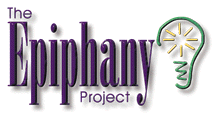Our faculty development program began with the Epiphany Project's January 1997 Institute (at George Mason University in Fairfax, Virginia) which promised that
- In an atmosphere of collaboration and with a goal to take part in shared knowledge-building, participants will develop models for faculty development and support at their own institutions. A variety of sessions will be offered including presentations, demonstrations, hands-on experiences and small group work in order to address challenges posed by the demands of learning how to use technologies for teaching writing. Guided by national leaders in the computers and learning community, this Institute will support new discoveries about the cultural impact of computers on teaching and learning.
At the end of this Institute participants will have
- gained an overview of the impact of and theoretical implications of technologies on culture and pedagogies;
- started a plan for coordinated faculty development and change on a departmental level; and
- acquired an array of computer skills and resource information.
 In addition to an overview of pertinent literature and resources, and an examination of "how collaborative learning and composition theories 'translate' to an electronic environment," the promised topics included
In addition to an overview of pertinent literature and resources, and an examination of "how collaborative learning and composition theories 'translate' to an electronic environment," the promised topics included
- synchronous and asynchronous computer- mediated communication
- local area networks (LANs)
- email and Internet discussion lists
- software choices for networked classrooms
- the World Wide Web as a site for teaching, research and publication
- constructing your own Web page (HTML authoring basics)
- using MOOs for teaching and professional collaboration
- strategies for creating a technology-rich curriculum
- hands-on with leading software in the teaching of composition
- low-tech ways to emulate high tech applications (a very popular session!)
- coordinated campus planning around technology
Our Epiphany
We began from the premise that if our teachers were to meet the needs of students facing a world increasingly oriented toward and shaped by technology, those teachers needed to understand the ramifications of classroom technology beyond the conception of a computer as just another pedagogical tool. Our students would need to be confident in their ability to function in a world offering unlimited information, where people regularly access and analyze texts, data, and images from the World Wide Web, researching everything from the most mundane topics to the most esoteric. They would need to move freely and confidently among the various communication and information technologies surrounding them. And, ultimately, they would need to understand the ethical use and applications of those technologies. In order to ensure these goals for our students, we needed to begin by educating our faculty. If full literacy is desired for students, then training in multiple literacies must be available to teachers. If we want our students to be confident and ethical users of technology, we must begin by raising teachers' awareness of the uses - and potential abuses - of those technologies. We determined to create an atmosphere where committed teachers could explore these technologies in a supportive environment, where exemplary teachers could provide models and tutor their peers in the understanding and application of those models.
Epiphany delivered on its promises, and we came home with the beginnings of a plan to maximize the pedagogical impact of the technology available to us at the time. Our next steps would be to secure funding, to develop a practical model for our summer institutes, and to decide how to select participants.